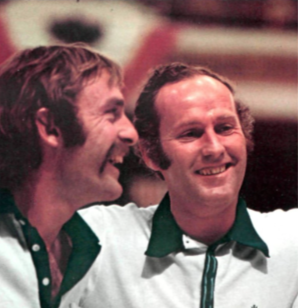The home fans seemed to know what was coming. The 1973 Davis Cup final, pitting the United States against Australia, was hosted in Cleveland, Ohio, the site of several recent international competitions, many of them attended by full houses of enthusiastic supporters.
On day one of the tie, which featured four of the best players on the planet, Cleveland’s Public Hall was half-empty. Certainly the Cup meant less to Americans than it did back in Australia: The US squad had held the trophy since 1968, while the Aussies hadn’t fallen short for so many consecutive years since before World War II. The matches were broadcast by satellite Down Under, and untold thousands of fans dragged themselves out of bed at five o’clock in the morning to see the first ball struck.
Stan Smith, the star of the US side, didn’t complain about the lackluster crowd. The previous year, his team had overcome hostile crowds, biased officials, and soggy clay in Bucharest. “The only condition against us here,” he said in Cleveland, “is pure talent.”
On November 30th, Smith kicked off the tie against US Open champion John Newcombe, proving that there was plenty of talent on both benches. The opening rubber could hardly have been any closer. Newcombe built a two-sets-to-one lead and led by a break in the fourth, when Smith chanced into a mis-hit return lob winner that brought him back even. The fifth set was a roller-coaster, with the returner taking a lead in eight of ten games, five of which went to deuce. Two overrules forced crucial points to be replayed, and Newcombe won both. Those near-misses, combined with a net-cord winner that gave the Australian match point, were the extent of the difference. In three hours and one minute, Newk pulled out the decision, 6-1, 3-6, 6-3, 3-6, 6-4.
The second match pitted Rod Laver against 27-year-old Tom Gorman. Gorman had sat out the semi-final against Romania, yielding his place to the veteran Marty Riessen. American captain Dennis Ralston felt that Gorman had the higher peak level of the two. (Ralston had also declined to call upon Arthur Ashe or Cliff Richey, two contract professionals who were technically ineligible for Davis Cup competition, but whom Australia had said they would allow to play.)
Gorman did indeed produce some of his best tennis, outplaying Laver for three sets before Rocket–probably the best come-from-behind player in the history of the game–discovered his own. Gorman took a hard-fought first set, 10-8, conceded the second, 6-8, and regained the lead in the third, 8-6. Only then did Laver fully let loose. By the fifth set, the 35-year-old was in control, breaking at love to open the frame and breaking again in the third game on the way to a 6-1 deciding set.
In seventy-plus years of Davis Cup play, only one team had ever come back from a two-love deficit in the final round, and that was Australia, who had overcome Bobby Riggs and the United States in 1939. Newcombe was in top form–Smith said he had never seen his opponent play better–Laver was revitalized, and no less of an alternate than Ken Rosewall was ready on the bench. The crowd in Cleveland was subdued, and it was easy to see why.
* *
This post is part of my series about the 1973 season, Battles, Boycotts, and Breakouts. Keep up with the project by checking the TennisAbstract.com front page, which shows an up-to-date Table of Contents after I post each installment.
You can also subscribe to the blog to receive each new post by email:
